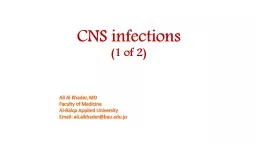

Ali Al Khader MD Faculty of Medicine AlBalqa Applied University Email alialkhaderbauedujo We will discuss viral encephalitis and prion diseases Viral encephalitis general A parenchymal ID: 930923
Download Presentation The PPT/PDF document "CNS infections (2 of 2)" is the property of its rightful owner. Permission is granted to download and print the materials on this web site for personal, non-commercial use only, and to display it on your personal computer provided you do not modify the materials and that you retain all copyright notices contained in the materials. By downloading content from our website, you accept the terms of this agreement.
Slide1
CNS infections(2 of 2)
Ali Al Khader, MDFaculty of MedicineAl-Balqa Applied UniversityEmail: ali.alkhader@bau.edu.jo
We will discuss viral encephalitis and prion diseases
Slide2Viral encephalitis, generalA parenchymal infection of the brain that is almost invariably associated with meningeal inflammation (meningoencephalitis)The most characteristic histologic features are perivascular and parenchymal mononuclear cell infiltrates, microglial nodules,
and neuronophagia (whatever the virus type)Certain viruses also form characteristic inclusion bodiesThe nervous system is especially susceptible to certain viruses (rabies and polio)
Slide3Viral encephalitis, general, cont’dSome viruses especially infect certain cell types Some other viruses especially affect certain regions, e.g., medial temporal lobes, or the limbic system that lie along the viral route of entryIntrauterine viral infection following transplacental spread
of rubella and CMV may cause destructive lesions, and Zika virus causes developmental abnormalities of the brainIn addition to direct infection of the nervous system, the CNS also can be injured by immune mechanisms after systemic viral infections
Slide4Viral meningoencephalitis, general morphology
Perivascular cuffing by lymphocytesMicroglial nodule
Destruction
of
parenchyma
Microglial nodule
…including multinucleated
Giant cells
Slide5ArbovirusesUsually epidemic in certain tropical areasSerious morbidity and high mortalityOf the common types: Eastern and Western equine encephalitis and West Nile virus infection (in western hemisphere)Generalized neurologic symptoms, such as seizures, confusion, delirium, and stupor or coma, as well
as focal signs, such as reflex asymmetry and ocular palsies.CSF: -slightly elevated pressure -early neutrophilic pleocytosis that rapidly converts to a lymphocytosis-protein concentration is elevated, but the glucose is normal
Slide6Herpes virusesRegarding HSV-1 -At any age group but is most common in children and young adults -Alterations in mood, memory, and behavior, reflecting involvement
of the frontal and temporal lobesTLR3 deficiency…recurrent herpetic encephalitisHSV-2 also affects the nervous system, usually in the form of meningitis in adults …can cause disseminated severe encephalitis in newborns of women that have active genital disease (normal delivery)Varicella-zoster virus (VZV) …chickenpox: usually no evidence of neurological involvement …latent infection in neurons of dorsal root ganglia
…reactivation: shingles in 1 or few dermatomes…
ususally
self-limited
…may cause persistent post-herpetic neuralgia
…may cause granulomatous arteritis with infarctions
…may cause encephalitis in the
immunocompromized
Nuclear inclusions
Slide7Cytomegalovirus (CMV)Fetuses and the immunocompromizedAll cells within the CNS (neurons, glial cells, ependyma, and endothelium) are susceptible to infectionPeriventricular necrosis…then microcephaly with periventricular
calcificationIn adults: subacute, also more in periventricular locationNuclear and cytoplasmic inclusions
Slide8PoliovirusAn enterovirusMost often causes a subclinical or mild gastroenteritisIn a small fraction of cases, it secondarily invades the nervous system and damages motor neurons in the spinal cord and brain stem (paralytic poliomyelitis)
Flaccid paralysis with muscle wasting and hyporeflexia in the corresponding region of the bodyDeath may occur due to respiratory muscle paralysisPost-polio syndrome of weakness in the same distribution may occur 25-35 years after initial illness
Slide9Rabies virusIncubation period: 9-90 daysRemember: -Dogs, some bat species exposure (even without bite documentation), others -paresthesia at site of biteInitially with nonspecific symptoms of malaise, headache, and
fever …then extraordinary CNS excitabilityThe slightest touch is painfulViolent motor responses progressing to convulsionsContracture of the pharyngeal musculature may create an aversion to swallowing even water (hydrophobia)ManiaStupor progressing to coma and eventually death, typically from respiratory failure.
Negri
bodies
Slide10HIVCNS is commonly involved in AIDSDirect effect (HIV encephalitis) or by opportunistic infections and primary CNS lymphomaHAART decreased the incidence of neurological involvement but still there is a problem called: *HIV-associated neurocognitive disorder (HAND)
…ranging from mild to full-blown dementia …infection of microglial cells + an innate immune response …HIV-derived proteins + cytokines will cause the damage10% of the initial presentation of HIV infection: aseptic meningitis…the virus can be isolated from CSFIRIS = immune reconstitution inflammatory syndrome can occur after initiating anti-HIV therapy …not fully understood mechanism …rapidly developing cognitive impairment and cerebral edema
Slide11What do you know about PML?
Slide12Prion diseasesThe causative agent is an abnormal form of a cellular proteinSporadic Creutzfeldt-Jakob disease (CJD)Familial CJDIatrogenic CJDVariant Creutzfeldt-Jakob
disease CJDAnimal diseases such as scrapie in sheep and bovine spongiform encephalopathy in cattle (“mad cow disease”)
Slide13Prion diseases, pathogenesisPrion protein (PrP)…the causative agentIf a conformational change occurred from its normal shape (PrPc) to an abnormal conformation called PrPsc
(sc for scrapie)PrP normally is rich in α-helices, but PrPsc has a high content of β-sheets …so it becomes resistant to proteolysis (hence an alternative term for the pathogenic form, PrPres— i.e., protease-resistant)
Slide14CJDA rapidly progressive dementing illnessFirst onset of subtle changes in memory and behavior to death in only 7 monthsSporadic in approximately 85% of cases and has a worldwide annual
incidence of about 1 per million …usually older than 70 yearsFamilial forms caused by mutations in PRNP may present in younger individualsSpongiform transformation of the cerebral cortex and deep graymatter structures…the characteristic microscopic featureIn advanced cases, there is severe neuronal loss, reactive
gliosis, and sometimes expansion of the vacuolated areas
into
cystlike
spaces (“status
spongiosus
”)
*No inflammation
*Immunostaining for
PrPsc
is positive
Slide15Variant CJDStarted to appear in 1995Younger age of patientsEarlier behavioral manifestationsSlower progressionAmyloid deposition
Slide16Transmission?!
Slide17Thank You